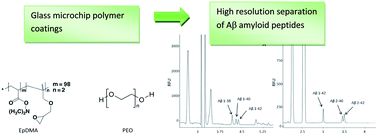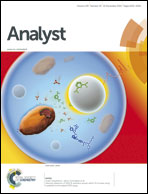Neutral polymers as coatings for high resolution electrophoretic separation of Aβ peptides on glass microchips†
Abstract
This study reports a comparison of the performances of two neutral polymers, poly ethylene-oxide (PEO) and poly(dimethylacrylamide-co-allyl glycidyl ether) (EpDMA), in glass microchips to achieve zone electrophoresis separation of several truncated forms of beta amyloid (Aβ) peptides, sharing very similar structures. The peptides were derivatized by FluoProbes 488 NHS to allow their fluorescence detection. Two protocols based either on PEO or EpDMA led to good pH stabilities in addition to a significant reduction of the electroosmotic flow. These two polymer coatings allowed repeatable analyses and high resolution for the simultaneous analysis of three Aβ peptides, Aβ 1-38, Aβ 1-40 and Aβ 1-42, considered as potential biomarkers of Alzheimer's disease. A recovery study showed that EpDMA was superior in reducing the adsorption of the Aβ peptides on the coated inner wall. Finally, the separation method relying on the EpDMA coated microchips was validated as linear using a calibration curve and the LOD was estimated to be close to 200 nM. Despite very short migration distances, different N-terminal or C-terminal truncated Aβ peptides, corresponding to promising biomarker combinations for the future diagnostic, were fully resolved. The method was successfully applied to detect these peptides in spiked cerebrospinal fluid and has provided a first achievement towards the development of a microsystem that would integrate preconcentration and separation steps.


 Please wait while we load your content...
Please wait while we load your content...